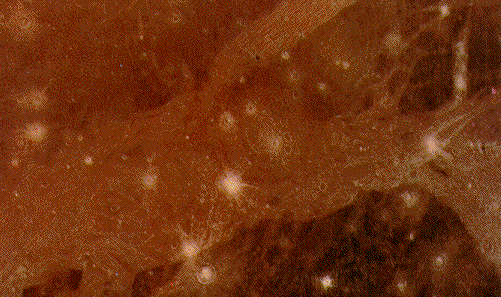Explanation: NASA's robot spacecraft Galileo began its long voyage to Jupiter in October of 1989. In December of last year it arrived in the Jovian system, beginning its unprecedented, detailed exploration by dropping a probe into the gas giant's atmosphere. By early this morning it will have accomplished another milestone in its ambitious mission. Now in orbit around Jupiter, Galileo will make its first close flyby of Ganymede, Jupiter's (and the solar system's) largest moon at 2:29 a.m. EDT. As planned, approaching to within 524 miles, it will make a series of high resolution images of the surface which will reveal features as small as 33 feet across. This close-up color image from the Voyager 2 flyby in 1979 previews sights Galileo will see in greater detail. Showing features as small as 3 miles across, it reveals a variety of terrain on Ganymede's icy surface, including impact craters with bright rays and long strips of light grooved structures suggesting large scale motions of the frozen crust. Galileo's flyby images will be stored onboard for playback and should be available during the week of July 10.
1999 2000 2001 2002 2003 2004 2005 2006 2007 2008 2009 2010 2011 2012 2013 2014 2015 2016 2017 2018 2019 2020 2021 2022 2023 2024 2025 |
Январь Февраль Март Апрель Май Июнь Июль Август Сентябрь Октябрь Ноябрь Декабрь |
NASA Web Site Statements, Warnings, and Disclaimers
NASA Official: Jay Norris. Specific rights apply.
A service of: LHEA at NASA / GSFC
& Michigan Tech. U.
|
Публикации с ключевыми словами:
космические корабли - Ганимед - галилеевы спутники - КА Вояджер - КА Галилео
Публикации со словами: космические корабли - Ганимед - галилеевы спутники - КА Вояджер - КА Галилео | |
См. также:
Все публикации на ту же тему >> | |
